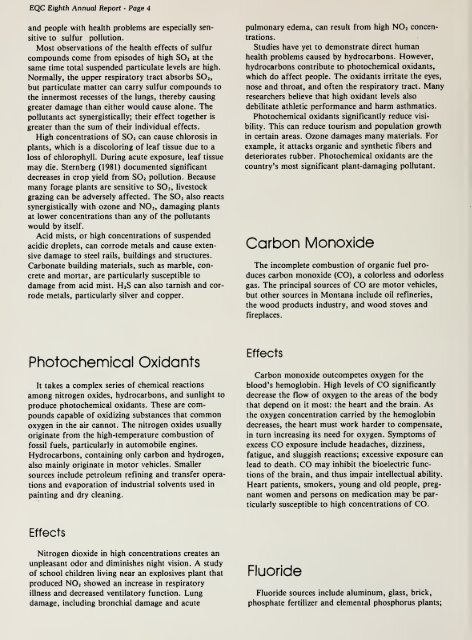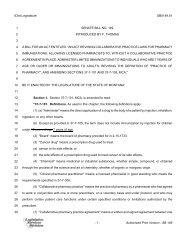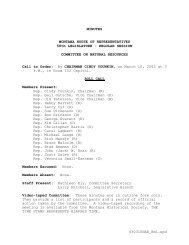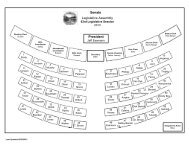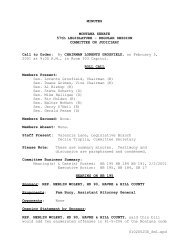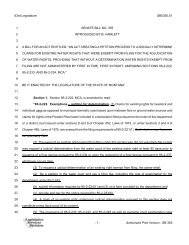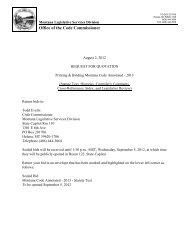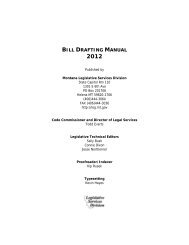EQC <strong>Eighth</strong> <strong>Annual</strong> <strong>Report</strong> - Page 4and people with health problems are especially sensitiveto sulfur pollution.Most observations of the health effects of sulfurcompounds come from episodes of high SO2 at thesame time total suspended particulate levels are high.Normally, the upper respiratory tract absorbs SO2,but particulate matter can carry sulfur compounds tothe innermost recesses of the lungs, thereby causinggreater damage than either would cause alone. Thepollutants act synergistically; their effect together isgreater than the sum of their individual effects.High concentrations of SO2 can cause chlorosis inplants, which is a discoloring of leaf tissue due to aloss of chlorophyll. During acute exposure, leaf tissuemay die. Sternberg (1981) documented significantdecreases in crop yield from SO2 pollution. Becausemany forage plants are sensitive to SO2, livestockgrazing can be adversely affected. The SO: also reactssynergistically with ozone and NO:, damaging plantsat lower concentrations than any of the pollutantswould by itself.Acid mists, or high concentrations of suspendedacidic droplets, can corrode metals and cause extensivedamage to steel rails,buildings and structures.Carbonate building materials, such as marble, concreteand mortar, are particularly susceptible todamage from acid mist. H2S can also tarnish and corrodemetals, particularly silver and copper.pulmonary edema, can result from high NO2 concentrations.Studies have yet to demonstrate direct humanhealth problems caused by hydrocarbons. However,hydrocarbons contribute to photochemical oxidants,which do affect people. The oxidants irritate the eyes,nose and throat, and often the respiratory tract. Manyresearchers believe that high oxidant levels alsodebilitate athletic performance and harm asthmatics.Photochemical oxidants significantly reduce visibility.This can reduce tourism and population growthin certain areas. Ozone damages many materials. Forexample, it attacks organic and synthetic fibers anddeteriorates rubber. Photochemical oxidants are thecountry's most significant plant-damaging pollutant.Carbon MonoxideThe incomplete combustion of organic fuel producescarbon monoxide (CO), a colorless and odorlessgas. The principal sources of CO are motor vehicles,but other sources in <strong>Montana</strong> include oil refineries,the wood products industry, and wood stoves andfireplaces.Photochemical OxidantsIt takes a complex series of chemical reactionsamong nitrogen oxides, hydrocarbons, and sunlight toproduce photochemical oxidants. These are compoundscapable of oxidizing substances that commonoxygen in the air cannot. The nitrogen oxides usuallyoriginate from the high-temperature combustion offossil fuels, particularly in automobile engines.Hydrocarbons, containing only carbon and hydrogen,also mainly originate in motor vehicles. Smallersources include petroleum refining and transfer operationsand evaporation of industrial solvents used inpainting and dry cleaning.EffectsCarbon monoxide outcompetes oxygen for theblood's hemoglobin. High levels of CO significantlydecrease the flow of oxygen to the areas of the bodythat depend on it most: the heart and the brain. Asthe oxygen concentration carried by the hemoglobindecreases, the heart must work harder to compensate,in turn increasing its need for oxygen. Symptoms ofexcess CO exposure include headaches, dizziness,fatigue, and sluggish reactions; excessive exposure canlead to death. CO may inhibit the bioelectric functionsof the brain, and thus impair intellectual ability.Heart patients, smokers, young and old people, pregnantwomen and persons on medication may be particularlysusceptible to high concentrations of CO.EffectsNitrogen dioxide in high concentrations creates anunpleasant odor and diminishes night vision. A studyof school children living near an explosives plant thatproduced NO2 showed an increase in respiratoryillness and decreased ventilatory function. Lungdamage, including bronchial damage and acuteFluorideFluoride sources include aluminum, glass, brick,phosphate fertilizer and elemental phosphorus plants;
EQC <strong>Eighth</strong> <strong>Annual</strong> <strong>Report</strong> - Page 5coal-burning industries can also emit fluoride. In<strong>Montana</strong> there are two major stationary sources offluoride: the ARCO aluminum smelter in ColumbiaFalls and Stauffer Chemical Company's elementalphosphorus plant in Ramsay. The coal-fired powerplants in Colstrip, BilHngs and Sidney and oilrefineries in Billings and Great Falls also release somefluorides.EffectsHigh concentrations of fluoride can harm vegetation,animals and humans. Some researchershypothesize that fluorides are carcinogens and cocarcinogens.Fluoride can reduce the red blood cellcount, thereby decreasing oxygen uptake within thebody. Plants accumulate fluoride. Excessive amountsinhibit the plants' metabolic processes of photosynthesis,growth, and reproduction. Such damageultimately kills the affected tissue. Animals that grazeon vegetation contaminated by fluoride also accumulatethe pollutant in their bones and teeth, causingtooth loss and fluorosis, a crippling bone disease. Thiscan be fatal for such grazing animals as cattle.Therefore, fluoride pollution can cause majoreconomic damage.beryllium, cadmium and lead, are toxic. Second, theaccumulation of non-toxic fine particles can"overload" the lung and interfere with its selfcleaningability. Third, the particulate can enhance theharmful effects of other pollutants. The particles maycarry carcinogenic substances to the lungs. Throughinjury to lung and throat linings, TSP weakens thebody's resistance to infection. In general, high levelsof particulate matter increase new respiratorydisorders, aggravate existing respiratory diseases, andirritate eyes, nasal passages and skin. People sufferingfrom respiratory and heart ailments are extremely susceptibleto elevated particulate concentrations. Currently,the EPA is considering implementing an ambientstandard based on inhalable particulate toreplace the total suspended particulate standard it nowuses.Particulate in the air reduces visibility;large particlesabsorb light and small particles scatter light.Particles can also modify such weather conditions astemperature, humidity, cloud cover, precipitation andfog. It can help form secondary particles, such as acidsulfates and nitrates, that as acid snow or rain canseriously affect plants, animals and materials. Thecombination of sulfur oxides and particulate mattercauses serious economic loss through soiling anddeteriorating material. In addition, particles containingheavy metals accumulate in plants and animalsand may damage them after extended periods of lowlevelpollution.Suspended ParticulateSuspended particulate matter, or airborne particles,originate from both natural and man-made sources.Natural sources include forest fires and erosion. Manmadesources include industrial processes, unpavedroads, gravel and asphalt batch plants, agriculture,motor vehicles, transportation, incinerators, construction,residential heating devices and refuse-burningoperations. The particulate varies in size, form (solidor liquid) and chemical makeup. Coarse particlesrange between 2.5 micrometers (um) and 15 um indiameter. Fine particles range up to 2.5 um indiameter. Fine particulate remains suspended in theatmosphere for long periods, while coarse particulateusually settles out close to the source.Trace MetalsAirborne trace metals generally result from combustion,smelting, open pit mining and automobiles.Principal stationary sources of trace metals in <strong>Montana</strong>include the ASARCO smelter in East Helena(lead, cadmium and arsenic); the Berkeley open pitmine in Butte (pulverized ore and unconsolidated soilexposed to wind); and coal-fired power plants (lead,arsenic, nickel, copper, zinc, selenium and cadmium).The emissions from coal-burning facilities vary considerablywith the composition of the coal.Automobiles using leaded gasoline are a major nonstationarysource of airborne lead particles.EffectsEffectsThe nose and throat usually trap coarse particles,preventing serious health threats. But fine particulatecan penetrate the deep recesses of the lungs. Fine particulatecan adversely affect health in three ways.First, some airborne particles, such as asbestos.Trace metals present a serious health risk, even insmall concentrations, because many are highly toxic.They can accumulate and cause injury after longexposure to low levels. Lead can cause anemia, kidneymalfunction, brain damage and, ultimately, death.
- Page 1: MONTANAENVIRONMENTALQUALITY COUNCIL
- Page 7 and 8: PREFACEThis is the Eighth Edition o
- Page 9: CONTENTSMONTANA ISSUESAir Quality 3
- Page 13: AIR QUALITYEQC Eighth Annual Report
- Page 17 and 18: EQC Eighth Annual Report - Page 7Re
- Page 19 and 20: EQC Eighth Annua/ Report - Page 9In
- Page 21 and 22: EQC Eighth Annual Report - PageFall
- Page 23 and 24: EQC Eighth Annual Report - Page 13l
- Page 25 and 26: EQC Eighth Annual Report - Page 15B
- Page 27 and 28: EQC Eighth Annual fleporl - Page 17
- Page 29 and 30: EQC Eighth Annual Report - Page 19m
- Page 31 and 32: EQC Eighth Annual Heport - Page 21M
- Page 33 and 34: EQC Eighth Annual Report - Page 23B
- Page 35 and 36: EQC Eighth Annual Report - Page 25q
- Page 37 and 38: WILDERNESSEQC Eighth Annual Report
- Page 39 and 40: EQC Eighth Annual Report - Page 29S
- Page 41 and 42: EQC Eighth Annua) Report - Page 31w
- Page 43 and 44: EQC Eighth Annual Report - Page 33C
- Page 45 and 46: FORESTRYEQC Eighth Annua/ Report -
- Page 47 and 48: EQC Eighth Annual Report - Page 37R
- Page 49 and 50: EQC Eighth Annual Report - Page 39E
- Page 51 and 52: MINERAL RESOURCESEQC Eighth Annual
- Page 53 and 54: EQC Eighth Annual Report - Page 43L
- Page 55 and 56: EQC Eighth Annual Report - Page 45E
- Page 57 and 58: EQC Eighth Annual Report - Page 47a
- Page 59 and 60: EQC Eighth Annual Report - Page 49t
- Page 62 and 63: 6N6RGV R€SOURC€S RND FRCIUTICS
- Page 65 and 66:
EQC Eighth Annual Report - Page 51D
- Page 67 and 68:
EQC Eighth Annual Report - Page 53M
- Page 69 and 70:
EQC Eighth Annual Report - Page 55W
- Page 71 and 72:
EQC Eighth Annual Report - Page 57r
- Page 73 and 74:
EQC Eighth Annual Report - Page1982
- Page 75 and 76:
RENEWABLE ENERGYEQC Eighth Annuul R
- Page 77 and 78:
EQC Eighth Annual Report - Page 63I
- Page 79 and 80:
AGRICULTUREEQC Eighth Annual Heport
- Page 81 and 82:
EQC Eighth Annual Report - Page 67M
- Page 83 and 84:
EQC Eighth Annua/ Report Page -iPro
- Page 85 and 86:
HUMAN ENVIRONMENTEQC Eighth Annual
- Page 87 and 88:
EQC Eighth Annua] Report - Page 73E
- Page 89 and 90:
EQC Eighth Annual Report - Page 75s
- Page 91 and 92:
EQC Eighth Annua) Report - Page 77m
- Page 93 and 94:
EQC Eighth Annual Report - Page 79e
- Page 95 and 96:
EQC Eighth Annual Report - Page 81T
- Page 97 and 98:
EQC Eighth Annual Report - Page 83G
- Page 99 and 100:
EQC Eighth Annua) Report - Page 85F
- Page 101 and 102:
EQC Eighth Annual Report - Page 87A
- Page 103 and 104:
EQC Eighth Annua) Report - Page 89a
- Page 105 and 106:
EQC Eighth Annual Report - Page 91M
- Page 107 and 108:
EQC Eighth Annual Report - Page 93o
- Page 109 and 110:
EQC Eighth Annual Report - Page 95t
- Page 111 and 112:
EQC Eighth Annual Report - Page 97T
- Page 113 and 114:
EQC Eighth Annual Heporl - Page !FR
- Page 115 and 116:
EQC Eighth Annual Report - Page 101
- Page 117 and 118:
EQC Eighth Annual Report - Page 103
- Page 119 and 120:
EQC Eighth Annual Report - Page 105
- Page 121 and 122:
EQC Eighth Annual Report - Page 107
- Page 123 and 124:
Five-year Subdivision ActivityEQC E
- Page 125 and 126:
EQC Eighth Annual Report - Page 111
- Page 127 and 128:
EQC Eighth Annual Report - Page 113
- Page 129 and 130:
EQC Eighth Annual Report - Page 115
- Page 131:
EQCACTIVITIES
- Page 134 and 135:
EQC Eighth Annual Report - Page 120
- Page 136 and 137:
EQC Eighth Annual Report - Page 122
- Page 138 and 139:
EQC Eighth Annual Report - Page 124
- Page 140 and 141:
EQC Eighth Annual Report - Page 126
- Page 143:
NATURALRESOURCEISSUESIN THE48THMONT
- Page 146 and 147:
EQC Eighth Annual Report - Page 132
- Page 148 and 149:
EQC Eighth Annua) Report - Page 134
- Page 150 and 151:
EQC Eighth Annual Report - Page 136
- Page 152 and 153:
EQC Eighth Annual Report - Page 138
- Page 154 and 155:
EQC Eighth Annual Report - Page 140
- Page 156 and 157:
EQC Eighth Annual Report - Page 142
- Page 158 and 159:
EQC Eighth Annual Report - Page 144
- Page 160 and 161:
EQC Eighth Annual Report - Page 146
- Page 162 and 163:
EQC Eighth Annual Report - Page 148
- Page 164 and 165:
EQC Eighth Annual Report - Page 150
- Page 166 and 167:
EQC Eighth Annual Report - Page 152
- Page 168 and 169:
EQC Eighth AnnuaJ Reportallowing gr
- Page 170 and 171:
EQC Eighth Annual Report - Page 156
- Page 172 and 173:
EQC Eighth Annual Report - Page 158
- Page 174 and 175:
EQC Eighth Annual Report - Page 160
- Page 176 and 177:
EQC Eighth Annual Report - Page 162
- Page 178 and 179:
EQC Eighth Annual Report - Page 164
- Page 180 and 181:
EQC Eighth Annua) Report - Page 166
- Page 182 and 183:
EQC Eighth Annua) Report - Page 168
- Page 184 and 185:
EQC Eighth Annual Report - Page 170
- Page 186 and 187:
EQC Eighth Annual Report - Page 172
- Page 188 and 189:
EQC Eighth Annual Report - Page 174
- Page 191 and 192:
Montana Environmental Policy ActEQC
- Page 193 and 194:
EQC Eighth Annual Report - Page 179
- Page 195 and 196:
EQC Eighth Annual Report - Page 181
- Page 197 and 198:
EQC Eighth Annual Report - Page 183
- Page 199 and 200:
EQC Eighth Annual Report - Page 185
- Page 201 and 202:
EQC Eighth Annual Report - Page 187
- Page 203 and 204:
EQC Eighth Annual fleporl Page-natu
- Page 206:
1500 copies of this public document


